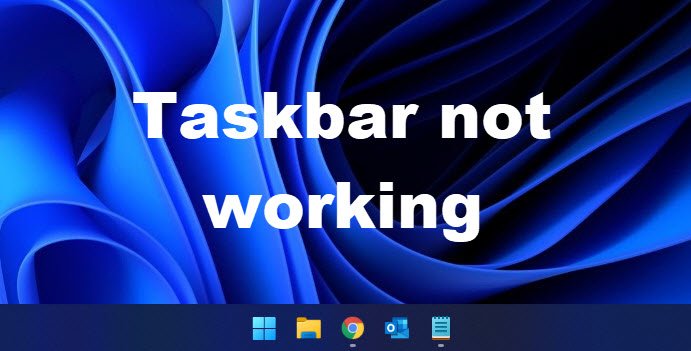The revamped Taskbar on Windows 11 includes the Start menu, Search box icons, Notification area, app icons, and more. By default, icons are center-aligned in Windows 11, and display the Taskbar at the bottom of the screen like in previous versions of Windows. However, you can move the Taskbar to the top of your PC screen.
Windows 11 Taskbar not working
If the Windows 11 Taskbar is not working or showing icons on your computer, you can try our recommended solutions below in no particular order and see if that helps to resolve the issue. Let’s take a look at the description of the process involved concerning each of the listed solutions. Before you try the solutions below, check for updates and install any available bits on your Windows 11 device and see if the issue is resolved.
1] Restart PC
The first thing you can try to fix the Windows 11 Taskbar is not working on your computer is to give your Windows 11 PC a quick restart. Restarting Windows PC usually resolves minor issues. If this action didn’t work for you, try the next solution.
2] Restart Windows Explorer and other essential processes
This solution requires you to restart the Windows Explorer process on your Windows 11 PC. To restart File Explorer in Windows 11, do the following: Additionally, while in Task Manager, click the Details tab, and restart the following processes:
ShellExperienceHost.exeSearchIndexer.exeSearchHost.exeRuntimeBroker.exe
3] Reset Windows 11 Taskbar
This solution requires you to Reset Windows Taskbar to default and see if that helps to resolve the issue.
4] Run SFC and DISM scan
If you have system file corruption, you’re likely to encounter this issue. In this case, you can run an SFC scan and see if that helps. If that didn’t help, you can run a DISM scan to fix bad system image which could also be the cause of the issue at hand. If you prefer, you can run the SFC and DISM scan in tandem using the procedure below.
Press Windows key + R to invoke the Run dialog.In the Run dialog box, type notepad and hit Enter to open Notepad.Copy and paste the syntax below into the text editor.
Save the file with a name and append the .bat file extension – eg; SFC_DISM_scan.bat and on the Save as type box select All Files.Repeatedly run the batch file with admin privilege (right-click the saved file and select Run as Administrator from the context menu) until it reports no errors.Restart your PC.
On boot, check if the issue is resolved. If not, proceed with the next solution.
5] Modify Registry
This solution requires you to create/edit the XAML (Extensible Application Markup Language) file in the Registry Editor. Since this is a registry operation, it is recommended that you back up the registry or create a system restore point as necessary precautionary measures. Once done, you can proceed as follows:
Press Windows key + R to invoke the Run dialog.In the Run dialog box, type regedit and hit Enter to open Registry Editor.Navigate or jump to the registry key path below:
At the location, right-click on the blank space on the right pane and then select New > DWORD (32-bit) Value to create the registry key and then rename the key as EnableXamlStartMenu and hit Enter.Double-click on the new entry to edit its properties.Input 0 in the Value data field.Click OK or hit Enter to save the change.Exit Registry Editor.Restart your PC.
On boot check if the issue is resolved. If not continue with the next solution.
6] Perform System Restore
If the taskbar was working fine earlier, but recently started giving issues, you can simply perform System Restore to revert your Windows 11 computer to a working state when the taskbar was functioning normally.
7] Uninstall any recent Windows Update you may have installed
If the issue started after installing a Windows Update then you might want to consider uninstalling the update and see if it helps.
8] Cloud Reset Windows 11
As a last resort, you can reset Windows 11 using the Cloud Reset option to fix the issue. NOTE: Rusty says below in the comments that turning off Fast Startup helped him. Hope this helps!
How do I fix the unresponsive taskbar in Windows 10?
If the taskbar is unresponsive on your Windows 11/10 PC, you can try the following suggestions to fix the issue:
Restart Windows Explorer using Task Manager.Restart Windows Explorer using Command Prompt.Re-register Taskbar.Stop specific apps from launching at Startup.Rollback recent Windows Update.
Why is my taskbar frozen in Windows?
There could be a number of reasons why the taskbar is frozen on your Windows PC, including an incomplete operating system update, an update bug, corrupted system files, or corrupted user account files.
How do I unfreeze my taskbar?
To unfreeze the taskbar on your Windows 11/10 PC, do the following: Press Ctrl + Shift + Esc to open Task Manager. In Task Manager, under the Windows Processes section of the Processes Menu find Windows Explorer. Click on it and then Click on Restart button on the bottom right. Explorer will now restart and Taskbar should start working again.
What do you do when Task Manager won’t open?
If on your Windows 11/10 PC, the Task Manager is not responding, opening or disabled by an administrator, you can try any of the following methods to open Task Manager:
Right-click the Taskbar and select Task Manager if you’re running Windows 10. For Windows 11, right-click Start Menu and select Task Manager.Press Ctrl+Shift+Esc.Press Ctrl+Alt+Del and then select Task Manager from the next screen.Type taskmgr in Start search or Run dialog box and hit Enter to open the Task Manager.
Related post: Fix Unclickable Taskbar; Can’t click on Taskbar in Windows 11/10.

